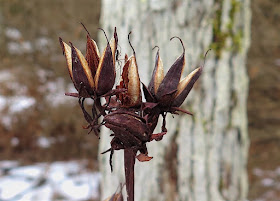One post that particularly struck me is one I composed way back in January, 2009, the first month I started blogging. I was sitting on some snowy rocks overlooking the frozen Hudson River, where I had discovered the trails of two minks scooting across the snow-covered ice, and I mused about how much this amazing wild place meant to me. Here are photos of that location and the mink trails I saw, followed by my response to them.
"On days like this and in places like this, I feel like a 12-year-old kid, like a kid in a candy store with a hundred bucks in my pocket. Most people I know love to travel to foreign places and visit exotic sights. I've done some of that. But all the time I was passing through it felt like I was only looking at places through glass. I didn't know how to truly inhabit them. But here . . . . Here on this river . . . . I've been here at least fifty, sixty, maybe more than a hundred times, in all seasons, weathers, times of day; I know the names of just about everything that grows and lives here, flora and fauna; I know what plants are good to eat and where the orchids grow; and yet, every time I visit, it all seems terra incognita.
"I never know what I might find. One spring morning I nearly stepped on a tiny brand-new fawn curled in the grass at my feet, so close I could sense its breath pass in and out of its nostrils. One autumn evening I watched a young beaver drag a twig to the water's edge and proceed to gnaw away on it. One cold but brilliant January afternoon I saw a pair of bluebirds high in a tree, their rosy breasts the only color in the winter landscape. And some day . . . maybe one of these days . . . I just might lay my eyes on the actual creatures who inhabit these surrounding woods and whose trails criss-cross this snow-covered ice -- the coyotes, foxes, minks, and fishers, and every rare once in a while, a pair of playful otters."
Amazing! I still feel just as much in awe of this special place, even after 11 years and dozens and dozens more visits. I should have given up on actually spying the critters I mentioned, since in all these years I've caught only fleeting glances of one single coyote's retreating rear end and one surprised mink's little bright-eyed face before it disappeared behind some riverside rocks. But hope never dies! Their myriad tracks reveal that these creatures still live here. And the magic of this marvelous place still beckons. Time to get out of my chair and back to the riverside!































